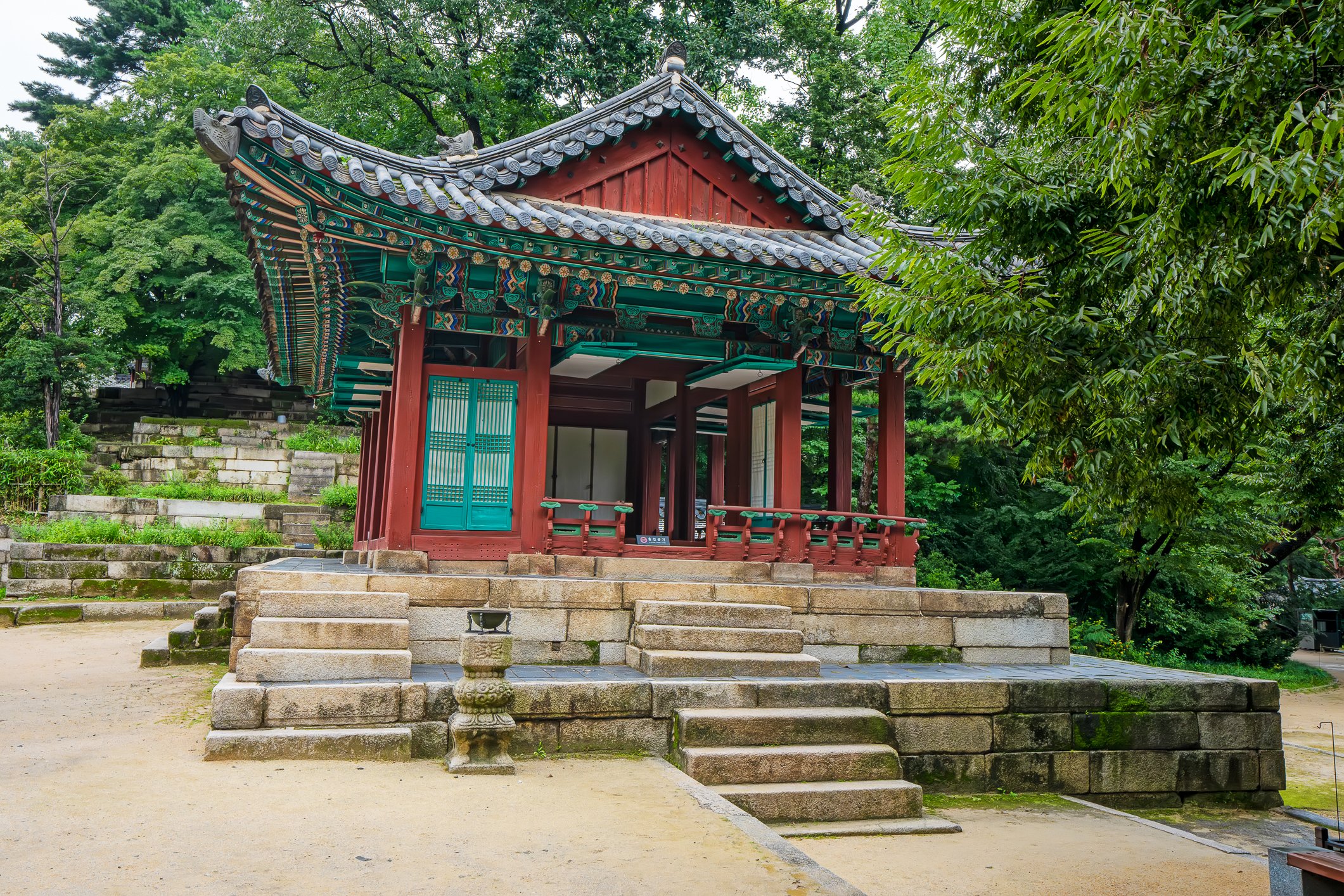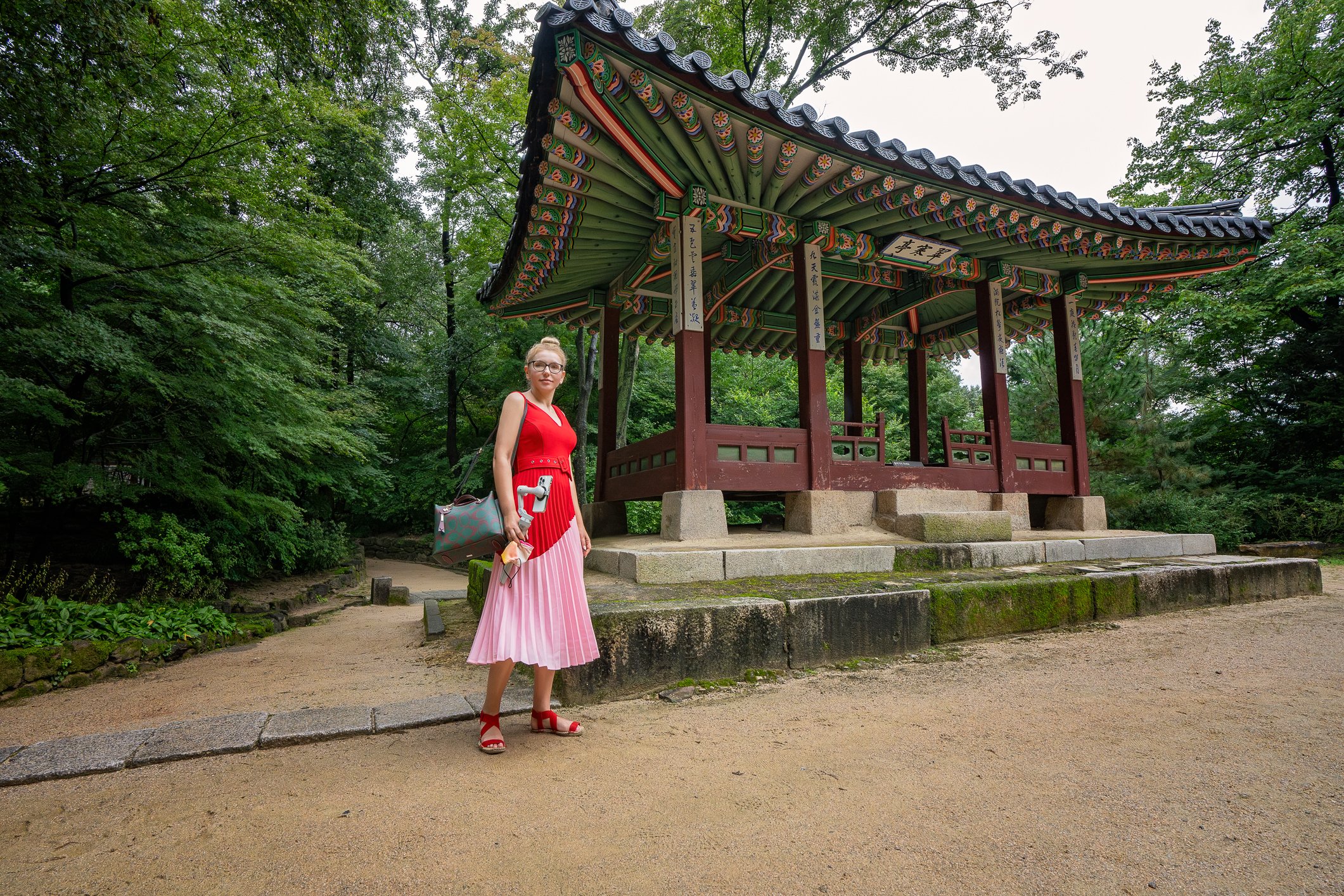As we cross the Geumcheongyo (금천교), a spacious stone bridge noted for its symbolism of purification for those who traverse it, we arrive at the middle gate of Changdeokgung (창덕궁), known as the Jinseonmun (진선문). This gate features a single-story gablet roof with double eaves.
Upon entering Jinseonmun, Injeongmun (인정문) is located to the left (north) and Sukjangmun (숙장문) straight ahead (east).
These gates are interconnected, and the corridors between them create a trapezoidal yard. This area has historically served as a venue for various events and was also used by the king for interrogating or punishing criminals.
Przechodząc przez Geumcheongyo (금천교), przestronny kamienny most, będący symbolem oczyszczenia dla tych, którzy go przekraczają, docieramy do środkowej bramy Changdeokgung (창덕궁), znanej jako Jinseonmun (진선문). Ta brama ma jednopiętrowy dach szczytowy z podwójnym okapem.
Po przejściu przez Jinseonmun, widzmy dwie kolejne bramy: Injeongmun (인정문) - znajduje się po lewej (na północ), a Sukjangmun (숙장문) na wprost (wschód).
Bramy te są ze sobą połączone, a korytarze między nimi obrysowują trapezoidalny dziedziniec. Obszar ten historycznie służył jako miejsce różnych ceremonii i był również wykorzystywany przez króla do przesłuchiwania lub karania przestępców.
Next, we proceed past Injeongmun (인정문), which leads to Injeongjeon (인정전), the hall where the king and his officials convened for important conferences. Injeongmun features a hipped roof, and its lower section includes a stylobate and stairs constructed from pole stones. A staircase is positioned in front of the king's eokan.
Originally built in 1418 during the reign of King Taejong, Injeongmun was later destroyed and subsequently reconstructed. The existing gate is believed to have been completed in 1745.
Następnie przechodzimy przez bramę Injeongmun (인정문), która prowadzi do Injeongjeon (인정전), sali tronowej, w której król i jego urzędnicy zbierali się na ważne konferencje. Brama Injeongmun ma czterospadowy dach, a jej dolna część obejmuje stylobat i schody zbudowane z kamieni słupowych. Schody znajdują się na wprost eokanu króla.
Pierwotnie zbudowana w 1418 roku za panowania króla Taejonga, brama Injeongmun została później zniszczona, a następnie odbudowany. Uważa się, że istniejąca brama została ukończona w 1745 roku.
Every palace features a main hall, adorned with decorations that symbolise the power and authority of the king. Injeongjeon served as the throne hall of Changdeokgung and was the venue for significant state affairs, including the coronation of new kings and the reception of foreign envoys. Originally constructed in 1405, the hall was rebuilt in 1610 following its destruction during the Japanese invasion of 1592, and again in 1804 after another fire.
Injeongjeon is supported by a high foundation stone placed on a wide, two-tiered platform known as Woldae, overlooking an expansive ceremonial courtyard. The building occupies 20 kan and is designed as a two-story structure, with an open interior that lacks partitions between the two levels. Its hipped roof features double eaves and a complex bracket system characteristic of late Joseon Dynasty architecture. The roof is adorned with representations of the oyat flower, a symbol of the imperial court and the Korean Empire, which is a species of plum blossom native to Korea.
Każdy pałac posiada główną salę, ozdobioną dekoracjami symbolizującymi władzę i autorytet króla. Injeongjeon służył jako sala tronowa Changdeokgung i był miejscem ważnych wydarzeń państwowych, w tym koronacji nowych królów i przyjmowania zagranicznych posłów. Pierwotnie zbudowana w 1405 roku, sala została przebudowana w 1610 roku po jej zniszczeniu podczas japońskiej inwazji w 1592 roku, a następnie ponownie w 1804 roku po kolejnym pożarze.
Injeongjeon jest podtrzymywany przez wysoki kamień fundamentowy umieszczony na szerokiej, dwupoziomowej platformie znanej jako Woldae, z widokiem na rozległy dziedziniec ceremonialny. Budynek zajmuje 20 kan i jest zaprojektowany jako dwupiętrowa konstrukcja z otwartym wnętrzem, w którym brakuje przegród między dwoma poziomami. Jego czterospadowy dach ma podwójne okapy i złożony system wsporników charakterystyczny dla architektury późnej dynastii Joseon. Dach jest ozdobiony przedstawieniami kwiatu oyat, symbolu dworu cesarskiego i Imperium Koreańskiego. Jest to gatunek śliwy pochodzącym z Korei.
On either side of the hall, corridors with roofs provide additional space. The courtyard features a clear pathway down the centre, reserved for the king, with stone markers (pumgyeseok - 품계석) on either side indicating where officials would stand according to their rank. Civil servants occupied the east side, while military officers stood to the west.
Po obu stronach budynku korytarze z dachami zapewniają dodatkową przestrzeń. Przez środek dziedzińca biegnie ścieżka zarezerwowaną dla króla, z kamiennymi znacznikami (pumgyeseok - 품계석) po obu stronach wskazującymi, gdzie urzędnicy powinni stać według ich rangi. Urzędnicy państwowi zajmowali wschodnią stronę, podczas gdy oficerowie wojskowi stali po zachodniej.
Inside, two gilded phoenixes are featured in the centre of the ceiling. The interior is decorated with yellow cloth, curtains, and lighting, while windows and doors have been upgraded from traditional paper to glass.
Behind the high central pillars stands the throne, and behind the throne a folding screen is featured, decorated with the traditional “Irwoloakdo” (이르월악도), depicting the sun, the moon, and the five peaks.
And here we must conclude our visit, as the palace is closing for the night. However, we will certainly return to explore more in the future.
Wewnątrz, na środku sufitu, znajdują się dwa pozłacane feniksy. Wnętrze jest udekorowane żółtym materiałem, zasłonami i światlem, a w oknach i drzwiach tradycyjnego papier został zastąpiony szkłem.
Za wysokimi centralnymi filarami stoi tron, a za tronem znajduje się składany parawan, ozdobiony tradycyjnym „Irwoloakdo” (이르월악도), przedstawiającym słońce, księżyc i pięć szczytów.
I tutaj musimy zakończyć naszą wizytę, ponieważ pałac zamyka się już na noc. Na pewno tu jeszcze wrócimy w przyszłości.









































































































































































































